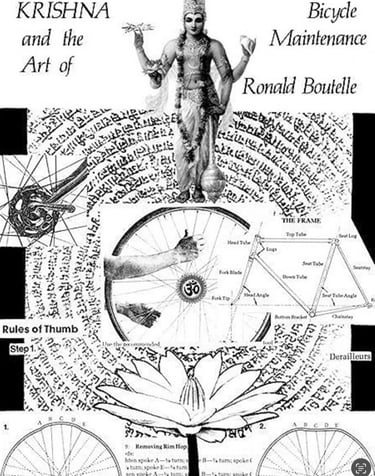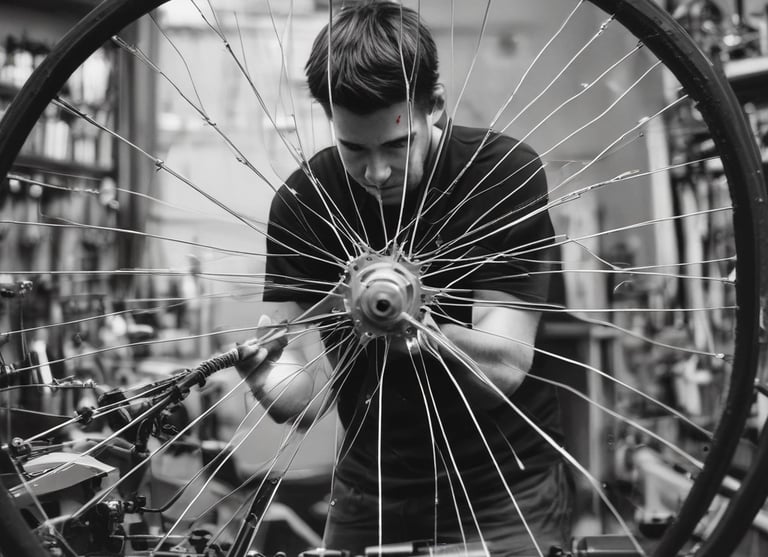Providing FREE vegetarian meals during times of natural disasters


- Preface -
There is nothing like a good book and I can always tell when I’ve found one. However, knowing my limitations I definitely didn’t set as my goal to write a “home run,” such as Zen and the Art of Motorcycle Maintenance, but rather, only hoping for a base hit.
Even so, I am well aware that any book worth reading should at least score well in the “interesting” category. As for this, all I can say is that I have tried with every ounce of wit I possess to write something that you will enjoy.
If you have ever considered writing a book, you know that it’s an enormous task. Somewhere in the third chapter I realized that there is no such thing as an unimportant word and by the time I finished the fourth chapter, where I began to relive working in my bicycle shop, I discovered that writing a book can be an awful lot like working on a bike, but a thousand times more difficult.
Let’s pretend that each chapter represents a bicycle wheel. Since I have written a book with six chapters, I could say that I have tried to build a bicycle with six wheels. So things are already more complicated!
The name of my bicycle shop was, The Adirondack Wheel Works. Most of my work consisted of repairing broken bikes. I didn’t sell new bicycles that can, at times, require the bicycle mechanic to assemble a wheel from “scratch.” Usually when we see a bicycle wheel, it has that familiar look, complete with so many spokes, a tire, etc. But at an expensive bicycle shop, a wheel can be purchased from a wide assortment of separate components (rims, spokes, axles, hubs, etc.), thus giving the customer the opportunity to create for himself just the wheel he wants.


The bicycle mechanic then assembles the finished wheel from the parts picked out. He carefully threads each spoke through the bare rim and eventually they are tightened to an exact torque to create a perfectly balanced wheel when given a quick spin. My bicycle shop was never this sophisticated but once or twice I did have to replace so many broken and missing spokes that I may as well have been assembling the wheel from “scratch.” It is quite a trick.
You start by loosening all the spokes and after you get the new spokes in place, using a small wrench, around the wheel you go, stopping at each spoke to tighten it.
The spokes are precisely paired across from each other to create a counterbalancing effect and as the spokes are tightened, tighter and tighter, you can sense the wheel becoming increasingly taut. Then, when you feel you have all the spokes tightened just right, you give the wheel a quick spin and look to see if it wobbles or remains true. And yes, over and over again you try, tightening and loosening, trying to get the wheel to spin without moving back and forth.
What does this have to do with writing a book? All I know is that after writing each chapter I’d “give it a spin” (proofread it), and to my constant dismay I’d find all kinds of wobbles in it. So out with the red pen, and I’d “tighten it up” here, and “loosen it up” there. Then I’d give it another spin. After about fifty attempts and thinking it was finally “true,” I’d beg one of my friends to also give it “a spin.” Without fail, back the chapters would come with more “tightening and loosening” to do. As I said, I’m not an accomplished writer.
Here is the complexity of the whole thing—a bicycle wheel only has about forty spokes, each needing to be tightened perfectly for it to spin true. But the six wheels (chapters) in this book contain literally thousands of spokes (words) and again, there is no such thing as an unimportant word, just as there is no such thing as an unimportant spoke.
When the spokes on a bicycle wheel are almost perfectly tuned, sometimes as it spins, only in one spot will you notice a little deflection. One misspelled word, or another mistake, creates the same thing. So the number of “wheels” on this “bike” are not only greater, they each contain thousands of “spokes” (words) that have to be just right, in so many ways. All I can say is that with the help of many “bicycle mechanics” (editors) from all over America, I have tried my very best. Furthermore, with so much time and effort having been invested to write Krishna and the Art of Bicycle Maintenance, naturally I want this book to “ride nicely.” Of course, I’m also hoping that you find it thought provoking—even a little heart provoking.
Once, being a gullible boy, I believed my teacher when she told me that Christopher Columbus discovered America in 1492. Then one day, a friend lent me his copy of Secrets of the Lost Races, by Rene Noorbergen (Barnes and Noble Books, 1977). Here I read that while excavating an ancient tomb in China, one of the oldest manuscripts ever discovered was unearthed. However, for the Chinese scientists who initially tried to decipher it, the pages just didn’t make sense and were actually ignored for many years.
Eventually the artifact was further examined and to the amazement of everyone, the manuscript turned out to be a 4500 year old scientific journal that had been kept by a team of Chinese explorers describing their expedition to North America. They tell of picking gold nuggets off the desert floor in Nevada and watching seals play on the rocks in San Francisco Bay. Not only were they entertained by a possum that played dead for them, one of the explorers penned a beautiful description of the Grand Canyon.
The most remarkable thing about my life is how I have been led to the truth. Perhaps I should say, “dragged to the truth.” Otherwise, I think I would have been quite content living out the remainder of my life in the beautiful Adirondack mountains and working in my bicycle shop. Quite naturally, one of the things that has accompanied me on my unexpected journey has been my desire to share what I have discovered with others. And believe me, if I wasn’t certain of its immense value, I wouldn’t waste your time.
Krishna and the Art of Bicycle Maintenance will not only entertain you—it is going to challenge you. It will challenge you to consider new ideas, as well as challenge you to look again at what you already know, but under a more intense light.
More so, Krishna and the Art of Bicycle Maintenance is a religious book. Not only does it try to embrace the correct approach for a book of this nature, it should also introduce you to new insights about God that you will find quite exciting.
As you will soon discover, I quote from many Scriptures, although I predominantly refer to the (Christian) Holy Bible and the (Hindu) Vedas when trying to substantiate certain ideas.
People of different faiths need to love one another, too. This has been the best part of writing my book, trying to explain how these two great religions are not so far apart as people might expect.
I can also say that by laying out my life in this book and connecting everything to God, I have found that everything has been made OK. This has, as you will read, helped me immensely.
Finally, Krishna and the Art of Bicycle Maintenance is about faith. This has been my greatest challenge because I am not a very faithful person. Not only has writing this book stimulated my own faith in God, it has given me a splendid opportunity to help others with theirs. If we can all finish this book with increased faith, then definitely my labor will have been well used.
The following acknowledgments are given with profound gratitude. I want to especially thank Mr. Steven J. Rosen who has given me permission to quote him. Mr. Rosen (Satyaraja Dasa) is also a disciple of Shrila Prabhupada. He is one of the most gifted writers and religious scholars alive today. Like Isaac Asimov, Mr. Rosen makes complex topics easy to grasp, as well as fun to read. He has published many books and anyone interested in interdenominational studies and the Hare Krishna movement will benefit by reading them. Many of his books can be found on Amazon.
The Bhaktivedanta Book Trust (the publishing arm of the Hare Krishna Movement) definitely needs to be acknowledged. With permission I have quoted several pages of material from their books.
It’s nice to have a best friend and I want to thank Mr. Kris Carlson (Krishna-katha dasa) for not only providing me with a beautiful picture of Lord Krishna, but also for offering valuable ideas on how to best present what I wanted to say.
Mr. Thomas Verdi designed my book’s cover, receiving nothing in payment but certainly earning my gratitude. I want to give him a big, “thank you.”
Credit is also extended to Celia Vale, Avis Christoff, and many others who have been kind enough to help with my book’s editing.
Finally, I want to thank H.H. Ganapati Swami for providing me with ways to show my readers how Sanskrit words are pronounced.
Please note that most of the Hare Krishna books I refer to are available through, Krishna Culture (https://www.krishnaculture.com) and Amazon.
I want to thank you for choosing to read Krishna and the Art of Bicycle Maintenance. I know that some of the following words will be unfamiliar to you; difficult if not impossible to pronounce. Please excuse any inconvenience that this may create. Unable to completely avoid using them, I have, nevertheless, reduced their usage as much as possible, without changing any of the ideas presented.
Ronald E. Boutelle / Rohini-suta dasa
Canyon Lake, Texas
Ai generated image
